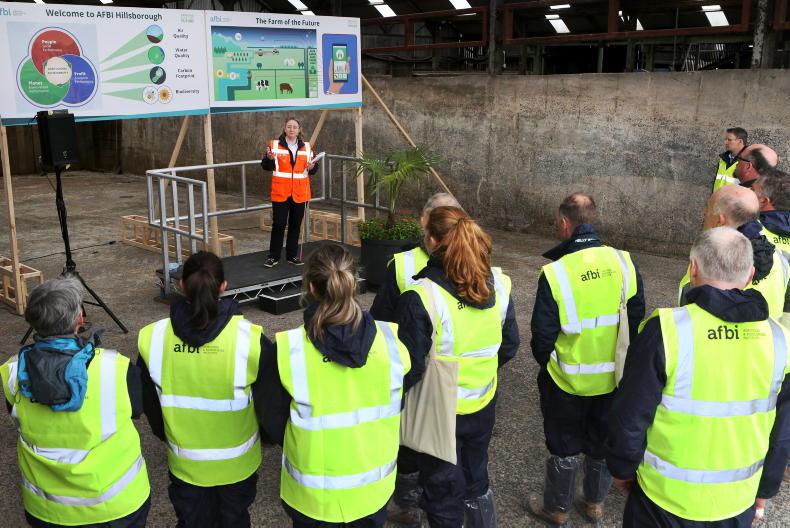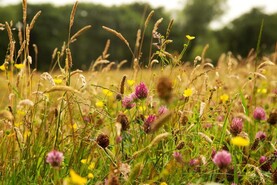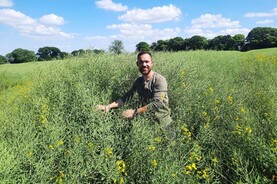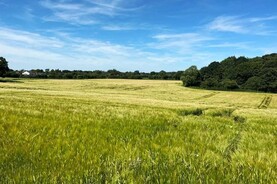Annual grass yields in NI are forecast to increase by 17% over the first half of the 21st century, according to Dr David Patterson from the Agri Food and Biosciences Institute (AFBI).
At an open day in Hillsborough, Co Down, on Tuesday, Patterson presented results from a scientific model which predicts how climate change will influence grass growth on local farms.
The exercise used climate change predictions from the UK Met Office and a long-standing model, known as GrazeGro, which forecasts how weather will affect grass growth.
“The results predict there will be an increase in the total annual grass yield in the coming decades by almost two tonnes of dry matter per hectare (tDM/ha),” Patterson said.
The headline figure is based on an average grass yield of 10.5tDM/ha in 2000, forecast to rise to 12.3tDM/ha by 2050.
“Overall grass growth will be higher but more variable, especially from April onwards. The growing season will be extended, however utilisation could be more difficult due to higher rainfall,” Patterson said.
Visitors to AFBI Hillsborough were told that for every 1°C increase in temperature, rainfall increases by 7%, and climate change will see average temperatures rise by between 1°C to 3°C by 2100.
Aside from impacting future grass growth, research conducted at AFBI has found that climate change has already affected how grass grows on NI farms.
Patterson said analysis of data from the GrassCheck project collected during the past 25 years shows that “the degree of variability” in grass growth has changed over the growing season.
“There has been a shift to more early season growth in March and April, later peak production in June, and much more fluctuations in growth during the summer,” Patterson added.
‘Biggest challenges for farming are environmental’
The main issues facing farming in NI over the coming years are related to the environment, a leading agricultural scientist has said.
“Our biggest challenge for the farming community is unfortunately the pressures that we exert on our environment,” said Professor Elizabeth Magowan from AFBI.
At the AFBI open day in Hillsborough on Tuesday, Magowan said there were four key environmental issues that NI agriculture must address.
The first item listed was air quality, particularly ammonia emissions.
“About 98% of ammonia emissions in NI are from livestock production,” Magowan said.
Water quality is another environmental problem in NI, with phosphorus run-off from farmland being the main issue related to agriculture.
“Phosphorus balance on farms is around 11-12kg/ha. We need to get that down to around 5kg/ha,” Magowan said.
Greenhouse gas emissions was the third issue listed. Visitors to the dairy open day were told that although NI dairying is carbon efficient in terms of emissions per litre, total emissions from the sector is on the rise.
“We are creating a lot of milk from our inputs, which is excellent. Our challenge is we have a very sizeable industry, and so gross emissions of greenhouse gases are high and have increased from 1990 levels,” Magowan said.
The AFBI professor said biodiversity was the fourth environmental challenge that needs to be addressed by NI farmers.
“There has been a lot of biodiversity lost over the years that we need to bring back.”

Professor Elizabeth Magowan giving the opening address at the AFBI open days. \ Houston Green
Annual grass yields in NI are forecast to increase by 17% over the first half of the 21st century, according to Dr David Patterson from the Agri Food and Biosciences Institute (AFBI).
At an open day in Hillsborough, Co Down, on Tuesday, Patterson presented results from a scientific model which predicts how climate change will influence grass growth on local farms.
The exercise used climate change predictions from the UK Met Office and a long-standing model, known as GrazeGro, which forecasts how weather will affect grass growth.
“The results predict there will be an increase in the total annual grass yield in the coming decades by almost two tonnes of dry matter per hectare (tDM/ha),” Patterson said.
The headline figure is based on an average grass yield of 10.5tDM/ha in 2000, forecast to rise to 12.3tDM/ha by 2050.
“Overall grass growth will be higher but more variable, especially from April onwards. The growing season will be extended, however utilisation could be more difficult due to higher rainfall,” Patterson said.
Visitors to AFBI Hillsborough were told that for every 1°C increase in temperature, rainfall increases by 7%, and climate change will see average temperatures rise by between 1°C to 3°C by 2100.
Aside from impacting future grass growth, research conducted at AFBI has found that climate change has already affected how grass grows on NI farms.
Patterson said analysis of data from the GrassCheck project collected during the past 25 years shows that “the degree of variability” in grass growth has changed over the growing season.
“There has been a shift to more early season growth in March and April, later peak production in June, and much more fluctuations in growth during the summer,” Patterson added.
‘Biggest challenges for farming are environmental’
The main issues facing farming in NI over the coming years are related to the environment, a leading agricultural scientist has said.
“Our biggest challenge for the farming community is unfortunately the pressures that we exert on our environment,” said Professor Elizabeth Magowan from AFBI.
At the AFBI open day in Hillsborough on Tuesday, Magowan said there were four key environmental issues that NI agriculture must address.
The first item listed was air quality, particularly ammonia emissions.
“About 98% of ammonia emissions in NI are from livestock production,” Magowan said.
Water quality is another environmental problem in NI, with phosphorus run-off from farmland being the main issue related to agriculture.
“Phosphorus balance on farms is around 11-12kg/ha. We need to get that down to around 5kg/ha,” Magowan said.
Greenhouse gas emissions was the third issue listed. Visitors to the dairy open day were told that although NI dairying is carbon efficient in terms of emissions per litre, total emissions from the sector is on the rise.
“We are creating a lot of milk from our inputs, which is excellent. Our challenge is we have a very sizeable industry, and so gross emissions of greenhouse gases are high and have increased from 1990 levels,” Magowan said.
The AFBI professor said biodiversity was the fourth environmental challenge that needs to be addressed by NI farmers.
“There has been a lot of biodiversity lost over the years that we need to bring back.”

Professor Elizabeth Magowan giving the opening address at the AFBI open days. \ Houston Green







 This is a subscriber-only article
This is a subscriber-only article










SHARING OPTIONS: